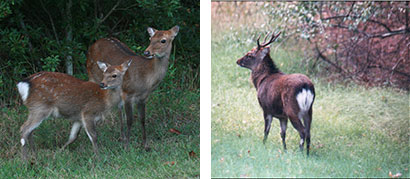Sika Deer
(Cervus nippon)
Description & Range:
Sika deer are small members of the elk family that have a dark brown to black coat. Sikas tend to keep their white spots as adults which are more prominent during summer. Males, aka stags, also have a dark shaggy mane running down their neck. Sika deer have a white rump patch that flares outward when alarmed. Proportionally to white-tailed deer, sika deer have shorter snouts and smaller ears. Sika antlers can reach lengths up to 15 inches. Sika stags typically weigh 90 pounds while females, aka hinds, weigh around 70 pounds. They are 2 ½ feet high at the shoulder.
Sika deer originate mostly from Japan, Taiwan, and East Asia. In the United States, sika deer have been introduced in various locations, including Texas, Virginia, and Maryland’s Eastern Shore. They were introduced to Maryland in the early 1900s when Clement Henry released 5 or 6 deer on James Island. Today, the population primarily inhabits Dorchester, Wicomico, Somerset, and Worcester counties as well as Assateague Island.

Sika hind and fawn at Assateague Island by Nancy Magnusson Flickr CC BY-NC 2.0 (left).
Sika stag by Brian Eyler, MD DNR.
Habitat:
Sika deer prefer marshes and thick forested wetlands and have established a population concentration in southern Dorchester County. Sika hinds typically have home ranges of about 1 square mile while stag home ranges can be much larger, especially during the breeding season. Hinds have also been found to move several miles for calving and then return to their home range.

Sika deer by Michael Ostendorp Flickr CC BY-NC 2.0
Diet:
Sika deer primarily feed at dusk through dawn on marsh vegetation, grasses and agricultural crops such as corn and soybeans. Bayberry, catbrier, and poison ivy are a few of the preferred food choices.
Reproduction:
Sika deer generally reach sexual maturity at around 16 months. The breeding season begins around late September and gestation lasts approximately 30 weeks, with most calves born in May. Almost always, births are single calves. Males tend to be very territorial and keep a harem of females during the breeding season. Hinds generally remain in small family groups with their young, sometimes including offspring from the previous year.
Sounds:
Sikas are one of the most vocal members of the Deer family (Cervidae) and have at least 5 distinct calls. During the fall and early winter breeding season, stags can be heard bugling, which is best described as a multi-pitched, extended wail. Hinds use soft bleats and whistles to communicate with other females and offspring, and their alarm call is a short, high-pitched bark.
Behavior:
During most of the year, sika hinds generally remain in small family groups with their young, sometimes including offspring from the previous year. Stags are largely solitary during fall and winter, and then form bachelor bands during late spring and summer. With the exception of the breeding season, stags and hinds typically remain segregated. Hinds during the day generally move about a half mile between feeding and bedding areas, while stags move much longer distances in a given day. Sika deer are also excellent swimmers and have no trouble navigating waterways.
Management:
Sika deer are a popular game species on the eastern shore, and hunters travel from many surrounding states during the fall hunting season. Large areas within Fishing Bay Wildlife Management Area and Blackwater National Wildlife Refuge are open to the public for Sika deer hunting.
For more information on deer management in Maryland please click here.
Did you Know?
- Sika deer employ bounce locomotion to flee danger, much like mule deer.
- China used to have the largest native Sika population but thousands of years of hunting and habitat loss have reduced the population to less than a thousand individuals.
- The velvet antlers of Sika deer are used in traditional Chinese medicine which led to domestication for the antler trade long ago.
- Its name comes from “Shika” the Japanese word for “Deer.”